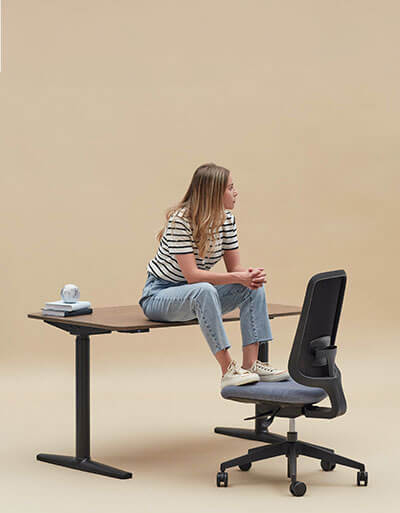At Slouch, we really care about ergonomic office design. It’s at the core of why we’ve poured years of product design into creating the ultimate comfortable adjustable office chairs.
Because you deserve a comfortable work place that allows you to focus on your work without any physical discomfort. The same goes for the rest of your office. There are dozens of ways you could finesse your environment to make sure it’s working with your body. We’ll take you through the top ones in this guide.
What is ergonomic office design?
The overall aim of ergonomics is to make the way we interact with the world more simple and comfortable. The idea is that when we create products or environments, they are made to fit the people using them, rather than forcing people to adapt uncomfortably.
Most areas of human life are improved by ergonomics on a daily basis. Think about the humble coffee mug, for example. Since at least 3500 BC, humans have been carving handles onto the side of vessels to make them more stable and comfortable to hold. That’s ergonomics in action.
Since we spend so much time at work, it makes sense that ergonomics can help make it a more pleasant experience for your body and, therefore, your productivity.
The proven health benefits
Adapting the workplace to have a more ergonomic office design doesn’t just make it feel nicer to use, it’s proven to reduce negative physical impacts on the body. Here are a few ergonomic examples of how.
Over 20 million people in the UK have musculoskeletal disorders – that’s almost one-third of the population! This includes conditions like arthritis, carpal tunnel syndrome, tendonitis and chronic back pain. Ergonomics can help to reduce the chances of developing musculoskeletal disorders. There’s a direct link between these conditions developing through awkward positions and repetitive movements that ergonomics can directly reduce.
That’s a pretty compelling health benefit on its own, but you’ll find that ergonomic office adjustments can also improve circulation, reduce eye strain and prevent headaches – plus loads more! We’ll take you through all of our recommendations and let you know what benefits they hold specifically.
Ways to create a more ergonomic workplace
Task chair
Let’s start with one of the most important additions to your workspace: an ergonomic work chair. You’ll likely spend many hours per day in your chair, so it needs to actually support you. A chair with no adjustability just can’t do that. That’s why it’s important to look for the ability to tailor the height, seat depth, backrest angle and arm positioning.
Lumbar support is the next big thing to look out for. Our spines naturally have a soft S shape to them. Chairs with no extra support in the lower back force your back into an unnatural C shape, resulting in back ache.
Finally, seek quality cushioning from your seat pad that reduces pressure points on your thighs and glutes.
You’ll find all of this in Slouch’s ergonomically engineered work chairs.
Health benefits: Reduces risk of back pain and musculoskeletal disorders, improves posture, enhances blood circulation to legs and prevents compression of internal organs.
Height-adjustable desk
When you work at a desk, your feet should be flat, and your arms should be able to rest comfortably at 90 degrees. Consider a height adjustable desk so that you can position your desk precisely at the right height for you, whether you’re sitting or standing.
That’s not the only reason to opt for one, though. The benefits of standing desks make for compelling reading – with them seriously helping to reduce the negative impacts of a sedentary lifestyle.
Health benefits: Reduces shoulder and neck pain, decreases risk of repetitive strain injuries, allows for position changes that improve circulation and energy levels.
Monitor adjustments
Have you ever heard the term ‘tech neck’? It’s an unfortunate phenomenon where the hunched, leant-forward posture from looking down at a screen causes strain on the neck muscles.
Combat this by having your monitors sit at eye level, with the top of the screen aligned with or slightly below your eye line. If this isn’t normally where your screens sit, consider investing in a monitor stand to help get the right screen positioning.
Health benefits: Prevents eye strain, reduces neck and upper back pain, minimises headaches, and maintains proper spinal alignment.
Ambience
Your working environment pays into your workspace ergonomics too. Consider your lighting for instance. Harsh, bright fluorescents can bring on headaches and eye strain. Combat this with good natural and additional task lighting.
Noise is another element that can steal focus. Add double-layer drywall with acoustic sealing and acoustic wall panelling to your office space planning checklist if you’re renovating your space – it can dramatically absorb sound and reduce how far it carries.
Don’t overlook temperature and air quality either! Workplace productivity peaks at temperatures between 21-22°C. Plus proper ventilation, air purifiers or even desk plants can improve oxygen levels and reduce pollutants to improve your cognitive function.
Health benefits: Decreases eye strain and headaches, improves concentration and mental clarity, reduces stress from environmental irritants and supports general wellbeing.
Activity areas
Movement is essential for beating the negative effects of sitting for many hours. Create spaces that encourage you to get up regularly. This could be a small corner with a yoga mat, a high table for quick stand-up chats or simply a clear area for stretch breaks. Some employers even run lunchtime walking or yoga sessions.
This prompts you to change positions throughout the day, giving your body relief from being stuck in one posture and recharging your mind in the process.
Health benefits: Improves cardiovascular health and boosts energy levels and mood.
Ergonomic accessories
The little extras you add to your ergonomic office design can make a massive difference to how comfortable you feel. Document holders keep your reading materials at eye level so you’re not constantly looking down and straining your neck. Wrist supports help keep your hands in a natural position during typing and mouse use, taking the pressure off your wrists.
If your feet don’t quite touch the floor when sitting, a simple footrest sorts that problem right away, helping your overall sitting posture. Plus, keyboard trays let you place your keyboard at just the right height and angle for your body type.
Health benefits: Prevents repetitive strain injuries, reduces wrist and hand pain, improves circulation to extremities and helps maintain proper posture throughout the day.
Ergonomic tech tools
The devices we interact with the most should be designed with the most physical comfort for the user in mind. For computer users, that means your mouse and keyboard.
Find ergo keyboard designs with split or angled designs that will keep your wrists in a more natural position. For mice, opt for trackballs to reduce the forearm twisting that contributes to repetitive strain.
Health benefits: Prevents carpal tunnel syndrome and other repetitive stress injuries, reduces tension in shoulders and forearms, plus minimises finger and hand fatigue.
Home office specific guidance
Working from home doesn’t mean your body deserves any less care. Here’s how to keep comfortable, even in a home office:
- Dedicated space – Carve out a specific area for work, creating boundaries between work and home life.
- Natural light – Position your desk near windows when possible. Good lighting reduces eye strain and improves mood.
- Proper setup – Apply the same ergonomic principles – supportive chair, screen at eye level, keyboard positioned for neutral wrists.
- Movement reminders – Set timers to prompt regular movement breaks throughout your day.
Is ergonomics a legal requirement for workplaces?
We’ve assembled a list of some of the ergonomic elements that are legally required in a work place, whether you’re working from home or from the office. That way, you can make sure that you’re doing your duty to staff. Or if you’re an employee, you can understand what an employer should be doing to help you thrive physically.
One of the key standards established by Health and Safety at Work etc. Act 1974 is that staff should be given a stable chair, that you can freely move in and allows a comfortable position. Ultimately, this aligns with principles of ergonomic seating – that adjustability and stability = comfort.
So if you’re searching for office chairs that give a comfortable sit all day with a huge range of adjustability – including lumbar support – Slouch is ready and waiting.

